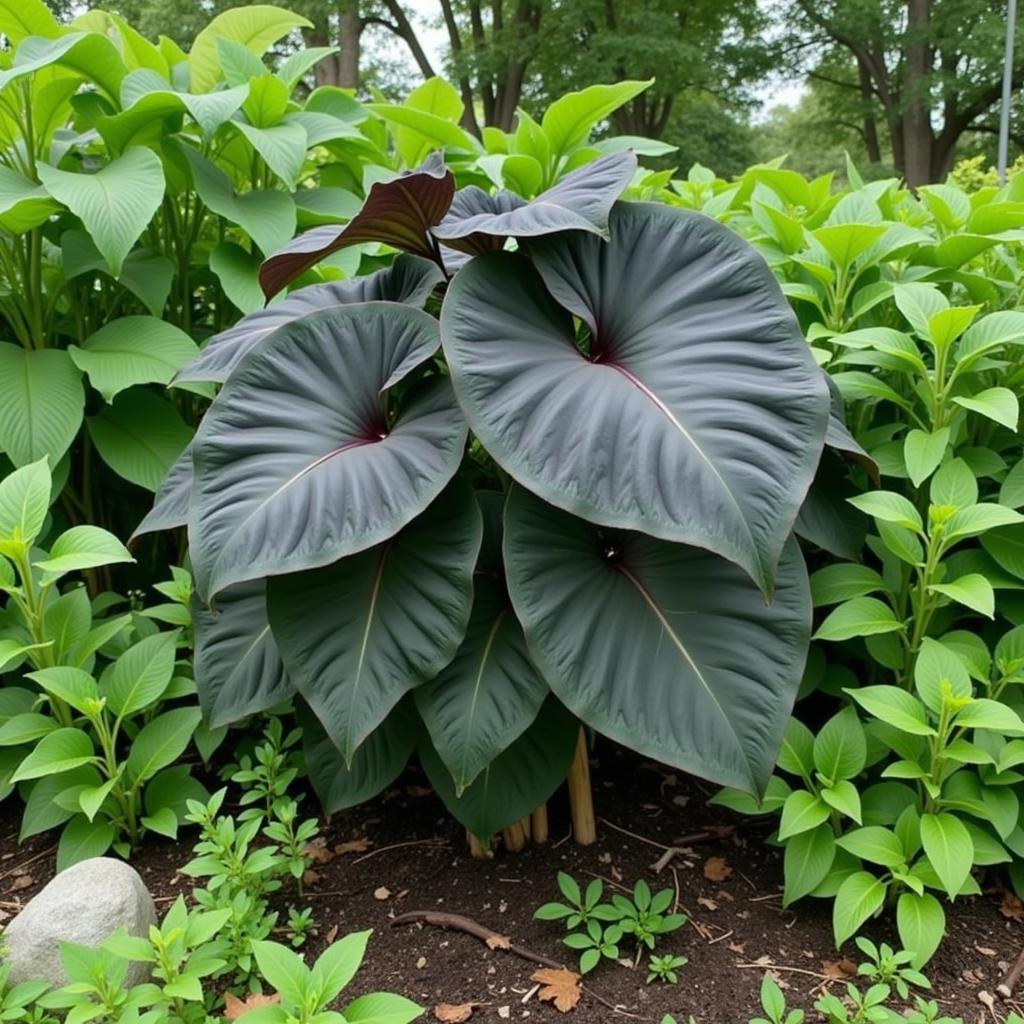Elephant ear plants, known for their dramatic foliage, bring a touch of the tropics to any garden or indoor space. But what colors do elephant ears come in? More than you might think! These striking plants offer a surprisingly diverse palette, far beyond the typical green. From deep purples and near-blacks to vibrant greens and even variegated varieties, elephant ears can add a splash of unexpected color and texture to your landscape.
Exploring the Color Spectrum of Elephant Ears
The term “elephant ear” actually encompasses several plant genera, including Alocasia, Colocasia, and Xanthosoma. This diversity contributes to the wide range of colors available. While many associate elephant ears with lush green foliage, there are cultivars boasting shades of deep purple, almost black, burgundy, and even vibrant chartreuse. Some varieties even display striking variegated patterns with combinations of green, white, cream, and pink. This diverse color palette allows gardeners and plant enthusiasts to create stunning visual displays, adding unique focal points to their indoor or outdoor spaces.
Deep Purples and Near-Blacks
For a dramatic and almost mystical look, consider dark-leaved elephant ear varieties. Cultivars like ‘Black Magic’ and ‘Black Coral’ boast deep purple-black foliage that appears almost black in certain light. These dark hues create a striking contrast against lighter-colored plants, adding depth and intrigue to the garden.
Vibrant Greens and Chartreuse
From vibrant emerald green to lighter, brighter shades, green elephant ear varieties provide a classic, lush backdrop. The cultivar ‘Lime Zinger’ stands out with its chartreuse foliage, adding a pop of vibrant color to any setting. These brighter greens can illuminate shady areas of the garden and create a sense of freshness.
Variegated Beauties
Variegated elephant ears offer perhaps the most unique and eye-catching color combinations. These varieties display patterns of green, white, cream, and even pink, adding an extra layer of visual interest. Cultivars such as ‘Pink Symphony’ and ‘Illustris’ are known for their stunning variegation.
Factors Affecting Elephant Ear Color
While genetics primarily determines the base color of an elephant ear, environmental factors can also influence the intensity and vibrancy of the foliage. Adequate sunlight is crucial for maintaining vibrant colors, particularly in variegated varieties. Nutrient deficiencies can also affect leaf color, causing them to appear pale or yellowed. Similar to how the color of an elephant can be perceived differently in various lighting conditions, as discussed in what colors are elephants, the perceived color of elephant ear plants can also be influenced by the surrounding environment.
Sunlight and Shade
Elephant ears generally thrive in partial shade, but the amount of sunlight they receive can impact their color. Too much direct sunlight can scorch the leaves, while too little can result in duller coloration, especially in variegated varieties. Finding the right balance is key to achieving optimal color intensity.
Soil and Nutrients
Rich, well-draining soil is essential for healthy elephant ear growth and vibrant foliage. A lack of certain nutrients, such as nitrogen or magnesium, can lead to yellowing leaves and diminished color intensity. Regular fertilization can help maintain optimal nutrient levels.
Choosing the Right Elephant Ear for Your Space
With such a diverse range of colors available, choosing the right elephant ear can seem daunting. Consider the existing color scheme of your garden or indoor space and choose a variety that complements or contrasts effectively. Also, consider the mature size of the plant, as some elephant ears can grow quite large.
Creating Stunning Combinations
Elephant ears can be paired with other tropical plants, such as ferns, cannas, and gingers, to create a lush and vibrant display. They can also be used as striking focal points in container gardens. The right combination can elevate your garden to a new level of visual interest. Knowing how colors interact, much like understanding if thinset color matter, can help you choose the best companions for your elephant ear plants.
Indoor vs. Outdoor Planting
Some elephant ear varieties are better suited for indoor growing, while others thrive outdoors. Consider your climate and available space when selecting a variety. Many elephant ears can be grown as annuals in cooler climates, while they can be grown as perennials in warmer regions.
 Black Magic Elephant Ear in Garden Setting
Black Magic Elephant Ear in Garden Setting
Conclusion
Elephant ears offer a surprising and delightful array of colors, adding a touch of tropical elegance to any space. From deep purples and near-blacks to vibrant greens and variegated beauties, there’s an elephant ear to suit every taste and garden style. By understanding the factors that influence their color and choosing the right variety for your space, you can create a truly stunning and captivating display. So, explore the world of elephant ear colors and let these magnificent plants transform your garden or indoor oasis into a vibrant paradise. If you need assistance with color selection or plant care, contact us at Phone Number: 0373298888, Email: [email protected] or visit us at 86 Cau Giay, Hanoi. We have a 24/7 customer service team ready to assist you.
FAQ
- Are all elephant ears the same color? No, elephant ears come in a wide variety of colors, including green, purple, black, and variegated patterns.
- What is the rarest elephant ear color? Variegated elephant ears with pink hues are considered some of the rarest and most sought-after.
- Do elephant ear colors change? While the base color is genetically determined, environmental factors like sunlight and nutrients can affect the intensity and vibrancy.
- What does a healthy elephant ear look like? A healthy elephant ear will have vibrant, unblemished leaves and a strong, upright stem.
- Can I grow elephant ears indoors? Yes, many elephant ear varieties are well-suited for indoor growing.
- How do I care for a variegated elephant ear? Variegated varieties often need more sunlight to maintain their vibrant colors.
- Where can I buy elephant ear plants? Elephant ear plants can be purchased from nurseries, garden centers, and online retailers.
Do you have other questions related to colors? Check out our other insightful articles like how do you make white food coloring and what is a color that starts with i. We also offer expert advice on various color-related topics. Contact us today for personalized assistance.

